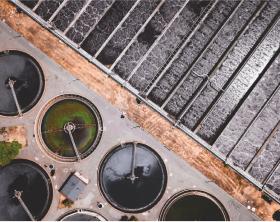Products
DropletSens™
Phosphate Analyser
Real-time, high-frequency, lab-quality phosphate monitoring.

Features
- Based on established Molybdenum Blue test
- Dissolved (ortho-)phosphate determined autonomously
- Fully quantitative
- On-device standard for performance checks
Specifications
Analytical
- Range
- 0 - 8 mg/L PO4-P
- Detection Limit
- 0.01 mg/L PO4-P
- Measurement Frequency
-
up to every 10 seconds
default setting is every 15 min
Operational
- Temperature range
- 0 - 35 °C
-
Power consumption** for continuous use measuring every 15 min
- 1.5 W
Physical
- Height
- 440mm
- Width
- 330mm
- Depth
- 200mm
- Weight
- 10.5kg
Communications
- Connectivity
- RS232/RS485, Modbus, Bluetooth, SCADA compatible
- Data output
- Remote streaming
Maintenance
- Reagent change after 3 months if in continuous use
- Required inlet filter change frequency depends on application
Applications
Process Control, Rivers, Streams & Lakes, Coastal, Agriculture, Phosphorus Reuse In Irrigation, Aquaculture, Industrial, Environmental Monitoring, Estuary Monitoring, Catchment Monitoring, Effluent Monitoring, Water Treatment, Network Protection Potable Water, Nutrient Mapping, Phosphorus Recovery, Phosphorus Removal, Nutrient Trading, Nature-Based Solutions Effectiveness Monitoring.

Why phosphate?
Phosphate is monitored in the water network and watercourses to better understand and reduce the environmental impact caused by sewage treatment outflows, storm overflows and agricultural run-offs, which can result in excessive algal growth and fish deaths. This pollution data can be used to guide investment decisions, monitor effectiveness of remedial measures such as wetlands, and support nutrient-trading schemes to unlock housing developments.
Apart from the dissolved ‘reactive phosphorus’ or ‘ortho-phosphate’ which DropletSens™ measures colorimetrically, there is also suspended or bound phosphorus, with all phosphorus compounds together adding up to ‘Total Phosphorus’ or ‘Total-P’. At present there are no electrochemical or spectral approaches that can measure ortho-phosphate.
Phosphate discharge limits are in place in most countries to protect the receiving ecosystems. Increasing focus is also placed on Phosphorus recovery, as it is a limited resource and required for fertilizer production.
In the UK, phosphate is sometimes added during water treatment to act as a corrosion exhibitor in the pipe network to prevent leaching of heavy metals, including lead, into drinking water.


Monitoring Solutions
Online analysers are for use outside the water source and as such require pumped solutions. To protect the equipment from suspended solids in the water, we offer a variety of pre-filtration solutions, including:
A. Passive filtration: large area non-biofoul polyethersulfone (PES) membranes.
B. Active filtration:
- B1. Self-cleaning pumped approach with Rotorflush module:

- B2. Ceramic silicon carbide (SiC) flat sheet membrane approach with back-and jet-washable Cembrane module:



